
Wine Culture and Information since 2002 - Volume 22
 Wine Culture and Information since 2002 - Volume 22 |
|
Contrasts di Lacrima di Morro d'Alba and Chianti Colli SenesiOne of the most famous red wines of the province of Ancona compared with the Chianti of the province of Siena. Different grapes and wines, decidedly distant personalities. |
|
The provinces of Ancona and Siena, in Italy, both have territories of notable viticultural vocation, famous and celebrated wines everywhere. In both provinces there are areas also recognized with the highest level of the Italian quality system, the Denominazione d'Origine Controllata e Garantita (Denomination of Controlled and Guaranteed Origin, DOCG). The two territories are separated by Umbria – specifically, by the province of Perugia – the environmental and meteorological conditions are decidedly distant and influence, last but not least, the characteristics of the respective wines. Both white and red berried grapes are grown in the vineyards of the provinces of Ancona and Siena, both enjoy excellent winemaking productions with both types of grape. In this regard, it should be noted the wines of the province of Ancona are identified in the productions based on white berried varieties – in particular, Verdicchio – in that of Siena it is the red wines to mostly characterize the enology of this province, strongly represented by Sangiovese. In both cases, however, there are excellent wines produced with other types of varieties, such as the reds of Conero and Lacrima di Morro d'Alba in the province of Ancona, Vernaccia di San Gimignano in the province of Siena. In this month's tasting by contrast we will pour into our glasses two important representatives of the respective provinces produced with red berried grapes, proving the interesting potential of these territories and which goes well beyond the respective main wines. As far as the province of Ancona is concerned, the wine we will examine is Lacrima di Morro d'Alba – produced with the homonymous grape – and, for that of Siena, Chianti Colli Senesi, mainly produced with Sangiovese. They are, as we will see, two very different wines and not only for the grapes with which are produced. In particular, they are wines result of very different enological practices such to give in the glass two completely different personalities and qualities.
|
|
In Morro d'Alba, in the province of Ancona, towards the Adriatic Sea, it is produced a fine wine taking the name from its main grape – Lacrima – also known as Lacrima di Morro d'Alba. This interesting red berried variety, with exuberant aromas of red and dark pulp fruits, owes its particular name to the fact that, when it ripens, the skin cracks, letting the juice drip, thus making the berry tear (lacrima is Italian for teardrop). Lacrima di Morro d'Alba – both the grape and the wine – boasts a long history and its first documented mention dates back to 1167. In fact, in that year, on the occasion of the siege of Ancona, Frederick Barbarossa settled in the castle of Morro d'Alba – not far from capital city of the Marches – forcing the inhabitants to deliver the most valuable products. Among these, the inhabitants of Morro d'Alba also brought their wine, which quality and value was already well known at those days. Lacrima di Morro d'Alba – also simply known as “Lacrima di Morro” – is recognized by the Italian quality system as Denominazione d'Origine Controllata (Denomination of Controlled Origin, DOC) and is also produced in the superiore and passito (sweet) styles. The best-known style is definitely the one that does not show any further distinctions on the label, a wine which is appreciated for its intense and exuberant aromatic qualities and its pleasing gustatory impact. This style, given its popularity, tends to dominate productions identified as “superiore” and “passito”, wines expressing greater complexity and structure, styles which certainly deserve in-depth interest from enthusiasts. The style we will consider in our tasting by contrast is the so-called “base” one, usually produced in inert containers in order to keep the aromatic expression of fruits and flowers typical of this style. The wine, in accordance with its production disciplinary, is produced with a minimum of 85% of Lacrima, while any remaining part can be composed of red berried grapes authorized or recommended in the Marches region.
|
||||
|
The wine production of the province of Siena is unequivocally and strongly associated to Sangiovese. In this territory, in fact, are produced many wines in which this famous red berried variety is used alone or together with other grapes. One of these certainly is Chianti Colli Senesi, one of the main representatives of enology in the province of Siena. The territory in which this wine is produced, and which extends entirely within the province of Siena, is recognized by the Italian quality system as Denominazione d'Origine Controllata e Garantita (Denomination of Controlled and Guaranteed Origin, DOCG). From a legal point of view, “Colli Senesi” is a sub-area of the large denomination “Chianti” and which also includes the sub-areas of Colli Aretini, Colli Fiorentini, Colline Pisane, Montalbano, Montespertoli and Rufina. The composition of Chianti Colli Senesi – in accordance with the production disciplinary – provides for a minimum of 75% Sangiovese, any remaining part is made up of red berried varieties suitable for cultivation in Tuscany. In this regard, it should be noted Cabernet Franc and Cabernet Sauvignon varieties, alone or together, cannot exceed the maximum limit of 10%. Chianti Colli Senesi provides for the “riserva” style, a qualification that is recognized only to wines aged in wooden containers for at least 8 months and followed by at least 4 months of aging in bottle. The character of Chianti Colli Senesi is mainly determined by Sangiovese and – in general terms – the wines of this appellation are characterized by a pleasing finesse and a medium structure, in which the contribution of wood becomes significant. Among the varieties which mainly make up this wine, in addition to the dominant Sangiovese, there are Canaiolo Nero, Colorino and Ciliegiolo, that is varieties which historically and traditionally are part of many red wines of Tuscany. The aging of Chianti Colli Senesi is usually done in wooden containers, however inert containers are also frequently used, such as steel and cement tanks. In these cases, the expression of Sangiovese gets a greater benefit, especially in the gustatory aspect, expressing its typical crispness. Furthermore, even when producers choose to use wood, in most cases it is done in a moderate way in order not to be excessive and respectful to the qualities of the Sangiovese.
|
Let's start preparing this month's tasting by contrast, by first purchasing the two wines we will pour into the glasses. Finding the bottles shouldn't be any difficulty, as these are two wines which enjoy a good production and diffusion. We will however try to compare wines produced in inert containers, such as steel and cement tanks, which is very frequent for Lacrima di Morro d'Alba, a little less for Chianti Colli Senesi. This enological characteristic will allow the grapes making up the two wines to express their sensorial characteristics without excessive alterations. In both cases we will also have to pay attention to the composition, as the respective disciplinary allows the use of many varieties. In the case of Lacrima di Morro d'Alba, we will make sure the wine is produced with the homonymous variety alone, while for Chianti Colli Senesi we will choose a bottle produced with at least 80% Sangiovese and the remaining part Canaiolo Nero. The two wines belong to the latest vintage and are poured into their respective tasting glasses at a temperature of 17 °C. (63 °F) Let's pour Lacrima di Morro d'Alba and Chianti Colli Senesi in their respective glasses and start the tasting by contrast by evaluating the appearance of the two wines. The first we are going to examine is Lacrima di Morro d'Alba, therefore let's tilt the glass over a white surface, for example a sheet of paper. By observing the base of the glass, we can see an intense and deep ruby red color, whereas transparency – evaluated by placing a contrasting object between the glass and the white surface – is decidedly very low. Let's now observe the wine towards the opening of the glass, where the thickness becomes thin, in order to evaluate nuances. We clearly notice a purplish red color, also proving the young age of the wine. Let's now pass to the evaluation of the appearance of Chianti Colli Senesi and, by tilting the glass over the white surface, in the base we can observe a brilliant ruby red color with a moderate transparency, decidedly higher than Lacrima di Morro d'Alba. The nuance of the Tuscan wine, observed towards the opening of the glass, confirms the ruby red color. The aromas of Lacrima di Morro d'Alba and Chianti Colli Senesi, although they share certain olfactory qualities of flowers and fruits, express completely different characters. In the red of the Marches the world of flowers is richly represented by rose, violet and cyclamen, while that of fruits is mainly made up of strawberry, raspberry, blackberry, black cherry and blueberry. Among the olfactory qualities making Lacrima di Morro d'Alba appreciated by consumers, is its exuberant aromatic strength expressed by the freshness of its primary olfactory descriptors, making it pleasing and direct, immediate and, so to speak, easy to understand. The profile of Chianti Colli Senesi is quite different and having a decidedly more “austere and mature” character, a quality which can be perceived even in its youth. The world of flowers in the Chianti Colli Senesi is mainly represented by violet and, sometimes, rose. The world of fruits of Chianti Colli Senesi is mainly expressed by black cherry, blueberry, raspberry and plum. Let's continue our tasting by contrast and proceed with the analysis of the olfactory profiles, by examining – just like in the previous phase – Lacrima di Morro d'Alba. By holding the glass in vertical position and without swirling, let's do the first smell in order to evaluate the opening of the wine, that is its primary and identifying olfactory sensations. From the glass can be perceived, clean, intense and pleasing, the aromas of strawberry, blackberry and raspberry, followed by the floral sensation of rose. After having swirled the glass – an operation favoring the development of the other olfactory qualities – and having done a second smell, the profile of Lacrima di Morro d'Alba is completed with blueberry, black cherry, plum and often pomegranate, as well as violet and cyclamen. Let's now pass to the evaluation of the olfactory profile of Chianti Colli Senesi and proceed with the examination of its opening. From the glass will be perceived intense and pleasing aromas of black cherry, plum and raspberry, followed by the elegant scent of violet. After having swirled the glass and done the second smell, the olfactory profile of Chianti Colli Senesi is completed with blueberry, often accompanied by the aromas of blackberry and rose. Let's now pass to the evaluation of the gustatory profiles of our wines, starting from the examination of Lacrima di Morro d'Alba. Let's therefore take a sip of the wine from the Marches and proceed with the evaluation of the attack, that is the primary and identifying gustatory sensations. In the mouth is immediately perceived the typical character of Lacrima di Morro d'Alba, in its pleasing crispness which finds balance in roundness, as well as a moderate and never aggressive astringency. We can also perceive flavors of strawberry, blackberry, raspberry and black cherry, with a strong and immediate character, absolutely pleasing. Let's now pass to the examination of the attack of Chianti Colli Senesi, therefore let's take a sip and evaluate the sensations perceived in the mouth. In this wine can be tasted a stronger crispness than the one from the Marche region – quality attributed to Sangiovese – with a lower roundness which is however enough for the balance. Astringency, also in this case not excessive, is definitely coherent with the gustatory profile and balance of the wine. Finally, in the mouth we perceive flavors of black cherry, plum, blueberry and raspberry, therefore a good correspondence to the nose. We are at the end of this month's tasting by contrast, therefore let's proceed with the evaluation of the sensations the two wines leave in the mouth after swallowing, in particular, the taste-olfactory persistence. The first wine of which we will evaluate the finish is Lacrima di Morro d'Alba. After having swallowed the wine, in the mouth we can still perceive the pleasing crispness and the exuberant fruit character typical of Lacrima di Morro d'Alba, as well as the pleasing roundness. In the mouth are continued to be perceived, with good persistence, the flavors of strawberry, blackberry, raspberry and black cherry, with a hint of astringency and good structure. The finish of Chianti Colli Senesi is equally persistent and, also in this case, the sensation perceived in the mouth is the union of the pleasing crispness and the gustatory qualities of black cherry, plum and raspberry. It also continues to be perceived the good structure of the wine and its pleasing astringency, decidedly not aggressive. Before concluding, let's proceed with the last comparative smell of the two wines, first Lacrima di Morro d'Alba and then Chianti Colli Senesi, an operation which will again highlight evident differences.
|
||||||||
Wines of the Month |
|
|
|
Score legend Prices are to be considered as indicative. Prices may vary according to the country or the shop where wines are bought |

|
|
Montefalco Sagrantino Etnico 2017 |
|
| Di Filippo (Umbria, Italy) | |
 Sagrantino Sagrantino | |
| Price: € 22.80 | Score: |
 Deep ruby red and nuances of garnet red, little transparency. Deep ruby red and nuances of garnet red, little transparency. Intense, clean, pleasing, refined and elegant, starts with hints of
blackberry, plum and dried violet followed by aromas of black cherry,
blueberry, carob, cocoa, tobacco, leather, licorice, vanilla and menthol. Intense, clean, pleasing, refined and elegant, starts with hints of
blackberry, plum and dried violet followed by aromas of black cherry,
blueberry, carob, cocoa, tobacco, leather, licorice, vanilla and menthol.
 Tannic attack and however balanced by alcohol, full body, intense
flavors, agreeable. Tannic attack and however balanced by alcohol, full body, intense
flavors, agreeable.
 Persistent finish with flavors of blackberry, plum and black cherry. Persistent finish with flavors of blackberry, plum and black cherry. 12 months in cask and barrique. 12 months in cask and barrique. |
|
 Game, Roasted meat, Stewed and braised meat, Hard cheese Game, Roasted meat, Stewed and braised meat, Hard cheese |
|
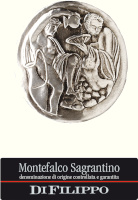
|
|
Montefalco Sagrantino 2017 |
|
| Di Filippo (Umbria, Italy) | |
 Sagrantino Sagrantino | |
| Price: € 33.60 | Score: |
 Deep ruby red and nuances of garnet red, little transparency. Deep ruby red and nuances of garnet red, little transparency. Intense, clean, pleasing, refined and elegant, starts with hints of
blackberry, plum and dried violet followed by aromas of black cherry,
blueberry, carob, tobacco, cinnamon, cocoa, mace, licorice, leather,
vanilla and menthol. Intense, clean, pleasing, refined and elegant, starts with hints of
blackberry, plum and dried violet followed by aromas of black cherry,
blueberry, carob, tobacco, cinnamon, cocoa, mace, licorice, leather,
vanilla and menthol.
 Tannic attack and however balanced by alcohol, full body, intense
flavors, agreeable. Tannic attack and however balanced by alcohol, full body, intense
flavors, agreeable.
 Persistent finish with flavors of blackberry, plum and black cherry. Persistent finish with flavors of blackberry, plum and black cherry. 24 months in cask. 24 months in cask. |
|
 Game, Roasted meat, Braised and stewed meat, Hard cheese Game, Roasted meat, Braised and stewed meat, Hard cheese |
|
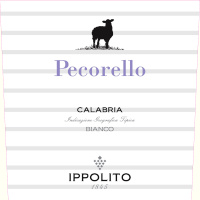
|
|
Pecorello 2021 |
|
| Ippolito (Calabria, Italy) | |
 Pecorello Pecorello | |
| Price: € 13.00 | Score: |
 Pale straw yellow and nuances of greenish yellow, very transparent. Pale straw yellow and nuances of greenish yellow, very transparent. Intense, clean, pleasing, refined and elegant, starts with hints of
apple, pear and citrus fruits followed by aromas of broom, hawthorn,
jasmine, peach, plum, pineapple, medlar, linden and mineral. Intense, clean, pleasing, refined and elegant, starts with hints of
apple, pear and citrus fruits followed by aromas of broom, hawthorn,
jasmine, peach, plum, pineapple, medlar, linden and mineral.
 Crisp attack and however balanced by alcohol, good body, intense
flavors, agreeable. Crisp attack and however balanced by alcohol, good body, intense
flavors, agreeable.
 Persistent finish with flavors of apple, plum and peach. Persistent finish with flavors of apple, plum and peach. Aged in steel tanks. Aged in steel tanks. |
|
 Pasta and risotto with fish and crustaceans, Sauteed fish, Sauteed crustaceans, Dairy products Pasta and risotto with fish and crustaceans, Sauteed fish, Sauteed crustaceans, Dairy products |
|
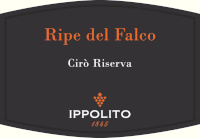
|
|
Cirò Rosso Classico Superiore Riserva Ripe del Falco 2013 |
|
| Ippolito (Calabria, Italy) | |
 Gaglioppo Gaglioppo | |
| Price: € 35.00 | Score: |
 Intense ruby red and nuances of garnet red, little transparency. Intense ruby red and nuances of garnet red, little transparency. Intense, clean, pleasing, refined and elegant, starts with hints of
prune, blackberry jam and dried violet followed by aromas of dried rose,
black cherry jam, blueberry jam, carob, cocoa, tobacco, leather, licorice,
rhubarb, porcino mushroom, mace, cinchona, vanilla and menthol. Intense, clean, pleasing, refined and elegant, starts with hints of
prune, blackberry jam and dried violet followed by aromas of dried rose,
black cherry jam, blueberry jam, carob, cocoa, tobacco, leather, licorice,
rhubarb, porcino mushroom, mace, cinchona, vanilla and menthol.
 Properly tannic attack and however balanced by alcohol, good body,
intense flavors, pleasing crispness. Properly tannic attack and however balanced by alcohol, good body,
intense flavors, pleasing crispness.
 Very persistent finish with long flavors of prune, blackberry jam and
black cherry jam. Very persistent finish with long flavors of prune, blackberry jam and
black cherry jam.
 Aged in cask. Aged in cask. |
|
 Roasted meat, Stewed and braised meat with mushrooms, Hard cheese Roasted meat, Stewed and braised meat with mushrooms, Hard cheese |
|
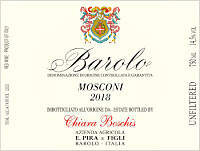
|
|
Barolo Mosconi 2018 |
|
| E. Pira & Figli - Chiara Boschis (Piedmont, Italy) | |
 Nebbiolo Nebbiolo | |
| Price: € 75.00 | Score: |
 Brilliant ruby red and nuances of garnet red, little transparency. Brilliant ruby red and nuances of garnet red, little transparency. Intense, clean, pleasing, refined and elegant, starts with hints of
cherry, plum and violet followed by aromas of rose, raspberry, strawberry,
cocoa, tobacco, coffee, cinnamon, mace, rhubarb, licorice, leather, thyme,
vanilla and menthol. Intense, clean, pleasing, refined and elegant, starts with hints of
cherry, plum and violet followed by aromas of rose, raspberry, strawberry,
cocoa, tobacco, coffee, cinnamon, mace, rhubarb, licorice, leather, thyme,
vanilla and menthol.
 Tannic attack and however balanced by alcohol, full body, intense
flavors, pleasing crispness. Tannic attack and however balanced by alcohol, full body, intense
flavors, pleasing crispness.
 Very persistent finish with long flavors of cherry, plum and raspberry. Very persistent finish with long flavors of cherry, plum and raspberry. 2 years in barrique. 2 years in barrique. |
|
 Game, Roasted meat, Stewed and braised meat with mushrooms, Hard cheese Game, Roasted meat, Stewed and braised meat with mushrooms, Hard cheese |
|
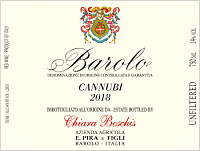
|
|
Barolo Cannubi 2018 |
|
| E. Pira & Figli - Chiara Boschis (Piedmont, Italy) | |
 Nebbiolo Nebbiolo | |
| Price: € 90.00 | Score: |
 Brilliant ruby red and nuances of garnet red, moderate transparency. Brilliant ruby red and nuances of garnet red, moderate transparency. Intense, clean, pleasing, refined and elegant, starts with hints of
cherry, plum and violet followed by aromas of rose, raspberry, strawberry,
chocolate, cinnamon, tobacco, licorice, leather, mace, rhubarb, thyme,
vanilla and menthol. Intense, clean, pleasing, refined and elegant, starts with hints of
cherry, plum and violet followed by aromas of rose, raspberry, strawberry,
chocolate, cinnamon, tobacco, licorice, leather, mace, rhubarb, thyme,
vanilla and menthol.
 Tannic attack and however balanced by alcohol, full body, intense
flavors, pleasing crispness. Tannic attack and however balanced by alcohol, full body, intense
flavors, pleasing crispness.
 Very persistent finish with long flavors of cherry, plum and raspberry. Very persistent finish with long flavors of cherry, plum and raspberry. 2 years in cask. 2 years in cask. |
|
 Game, Roasted meat, Stewed and braised meat with mushrooms, Hard cheese Game, Roasted meat, Stewed and braised meat with mushrooms, Hard cheese |
|
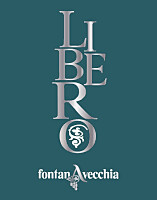
|
|
Falanghina del Sannio Taburno Libero 2017 |
|
| Fontanavecchia (Campania, Italy) | |
 Falanghina Falanghina | |
| Price: € 23.00 | Score: |
 Brilliant straw yellow and nuances of straw yellow, very transparent. Brilliant straw yellow and nuances of straw yellow, very transparent. Intense, clean, pleasing, refined and elegant, starts with hints of
apple, pear and peach followed by aromas of hawthorn, broom, citrus fruits,
plum, medlar, pineapple, hazelnut, linden and mineral. Intense, clean, pleasing, refined and elegant, starts with hints of
apple, pear and peach followed by aromas of hawthorn, broom, citrus fruits,
plum, medlar, pineapple, hazelnut, linden and mineral.
 Crisp attack and however balanced by alcohol, good body, intense
flavors, agreeable. Crisp attack and however balanced by alcohol, good body, intense
flavors, agreeable.
 Persistent finish with flavors of apple, pear and peach. Persistent finish with flavors of apple, pear and peach. Aged in steel tanks. A small part ages for 6 months in barrique. 12
months in bottle. Aged in steel tanks. A small part ages for 6 months in barrique. 12
months in bottle.
|
|
 Stuffed pasta with mushrooms, Roasted fish, Stewed white meat, Broiled fish, Mushroom soups Stuffed pasta with mushrooms, Roasted fish, Stewed white meat, Broiled fish, Mushroom soups |
|
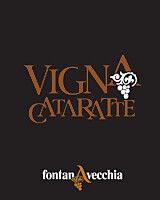
|
|
Aglianico del Taburno Riserva Vigna Cataratte 2017 |
|
| Fontanavecchia (Campania, Italy) | |
 Aglianico Aglianico | |
| Price: € 23.00 | Score: |
 Deep ruby red and nuances of garnet red, little transparency. Deep ruby red and nuances of garnet red, little transparency. Intense, clean, pleasing, refined and elegant, starts with hints of
plum, blackberry and black cherry followed by aromas of dried violet,
blueberry, cocoa, tobacco, cinnamon, licorice, clove, mace, leather, pink
pepper, graphite, vanilla and menthol. Intense, clean, pleasing, refined and elegant, starts with hints of
plum, blackberry and black cherry followed by aromas of dried violet,
blueberry, cocoa, tobacco, cinnamon, licorice, clove, mace, leather, pink
pepper, graphite, vanilla and menthol.
 Properly tannic attack and however balanced by alcohol, full body,
intense flavors, pleasing crispness. Properly tannic attack and however balanced by alcohol, full body,
intense flavors, pleasing crispness.
 Very persistent finish with long flavors of plum, blackberry and black
cherry. Very persistent finish with long flavors of plum, blackberry and black
cherry.
 36 months in steel tanks, 18 months in barrique, 12 months in bottle. 36 months in steel tanks, 18 months in barrique, 12 months in bottle. |
|
 Game, Roasted meat, Stewed and braised meat, Hard cheese Game, Roasted meat, Stewed and braised meat, Hard cheese |
|
|
||||||||
|
DiWineTaste Polls
|
| |||||||
Privacy Policy | |||||||


| Copyright © 2002-2024 Antonello Biancalana, DiWineTaste - All rights reserved |
| All rights reserved under international copyright conventions. No part of this publication and of this WEB site may be
reproduced or utilized in any form or by any means, electronic or mechanical, without permission in writing from DiWineTaste. |